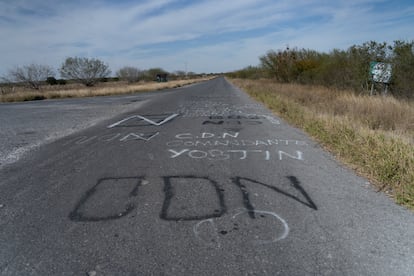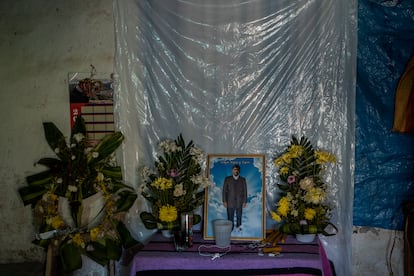The Tamaulipas massacre: how the American Dream dies in Mexico
They invested and risked everything in search of a better life, traveling to the United States without documents that would allow them to work. But they were found shot dead, and their bodies charred in the north of Mexico, a territory where migrants are preyed on by cartels and a corrupt system takes advantage of them. That’s how the hopes of a group of 15 Guatemalans turned into a nightmare. EL PAÍS has reconstructed their story
The Tamaulipas massacre:
How the American dream
dies in Mexico
dies in Mexico
The bad news reached the village of Tuilelén, in the rugged mountains of San Marcos, in the southeast of Guatemala, before midday. “Don Ricardo: our children are dead, burned, without a trace and without anything else.” It was a call from father to father, but also from ‘coyote’ to customer: from some point on the border between Mexico and the United States, the guide that Ricardo García Pérez had entrusted with the oldest of his daughters was confessing that all that remained of that jokey young 20-year-old were ashes. Even the son of the guide, who was in the same group, was among the dead.
It was Saturday, January 23. On the news, they were starting to talk about the discovery of 19 charred corpses – most of them from Guatemala – that had been found on a rural road between Tamaulipas and Nuevo León, a territory in the northeast of Mexico that in the last decade has become a cemetery for migrants. At that point, the fact that there were Guatemalans among the dead was just a rumor; although for parents such as Ricardo García Pérez, who had accompanied his children from their remote communities to the house of the coyote in the municipality of Comitancillo two weeks before, the lack of news from the group for days now and that phone call were enough. They were sure that it was them who had been in those charred white trucks, photos of which were being shared on social media. And also that with the killings, the investment of the little money that they had to spend had also gone up in smoke.
“My daughter was not murdered for being a thief or a criminal, nor smuggling drugs,” says García from one of the hills in the Tuilelén cemetery, while he digs the grave of his daughter Santa Cristina. “My daughter was murdered for being a fighter.”
Despite the blow of having lost the second of his 11 children in less than a month, the man – with shiny black hair, and skin that is burned from working in the countryside – has not lost his composure. “I have to follow the example that she set. She was kind, affectionate, cheerful,” he explains.
When the Mexican authorities return her remains, the youngster will be laid to rest among the graves of other migrants who also lost their lives in Tamaulipas: Iván Gudiel, 22, and Rivaldo Jiménez Ramírez, 18.
To pay for their daughter’s journey, García and his wife, Olga Pérez, requested a loan backed by the deed for their house, which is made of adobe and has a dirt floor. They also handed over the deed to the land that surrounds it – the size of two soccer pitches – where they grow the corn that feeds the family. With the 25,000 quetzales ($3,235) that they scraped together, the couple paid the coyote a part of what he demanded and also had enough to buy Santa Cristina clothes, shoes and a cellphone for the journey.
The money they handed over to the guide was not even a quarter of the 110,000 quetzales that he wanted for the journey. But they thought that once their daughter got to the US, she could pay their debts just as migrants who have left their community and headed north have done for decades.
“If Santa gets to the US, your life is going to change,” the youngster said to her father before she said goodbye. For months she had been asking her family to help her pay for the journey. Her plan was to work by day to pay off the debt, and work at night too so that they could afford surgery on her youngest sister’s cleft palate.
Like her, the majority of those who went in her group were under 25 – some were even minors. They came from large families, and they were fleeing the lack of opportunities in Comitancillo, a municipality of around 60,000 inhabitants that Tuilelén belongs to and where nearly 90% of the population lives in poverty. Nearly 20% of the inhabitants have emigrated to the US, an emergency option for millions of Central Americans since the 1980s due to the violence and the political and economic instability in the region.
Many of the remote villages and homesteads from which these migrants come can only be accessed in all-terrain vehicles or by walking for hours along dusty mountain tracks. In these places, the majority of families survive with the little that they produce – mostly potatoes, corn and beans – as well as by rearing a few chickens or some livestock, or with what they can earn working in the fields or in construction.
The signs of life from the Guatemalan state are few and far between, in contrast with what happens with money sent back home by other immigrants. Between the traditional adobe houses you can make out brick-and-cement constructions, paid for with the money of those who made it to the United States. That is why migrating is the safest option for many families who are seeking a better future. But it’s an option that, for Santa Cristina’s group, was dashed around 60 kilometers from the US border.
The line between the Mexican states of Nuevo León and Tamaulipas, near the border, is a patchwork of family farms, fields of sorghum and oil wells. And among them, the “ants:” thousands of trucks and trailers that cover the Monterrey-Reynosa-Nuevo Laredo route and that conceal one of the most lucrative activities on the Mexico-US border: the movement of migrants.
The trail of Santa Cristina’s group was lost 600 kilometers south of Monterrey, in San Luis Potosí. The bodies were found on an isolated path in Camargo, 200 kilometers to the northeast of Monterrey, in Tamaulipas. They were found with bullet wounds and burned, left abandoned in the middle of nowhere.

For more than a decade, Tamaulipas has been one of the most dangerous routes for migrants. In 2010, a criminal group murdered 72 Central and South Americans in San Fernando, by the Gulf of Mexico coast. The following year, the authorities found nearly 200 bodies in hidden graves in the same municipality. The majority were migrants. In 2012, the dismembered bodies of 49 people, among them some migrants, were left in Cadereyta, near Monterrey.
At the time, the government denounced the Los Zetas cartel as being behind the killings. In the case of San Fernando, one man who was detained, and who supposedly belonged to the group, stated that he had killed the migrants to avoid them being recruited by a rival cartel after most of them refused to join the ranks of his own gang.
The motives behind those murders were not clear. But there was always the suspicion that the criminals had counted on the direct or indirect complicity of the local authorities. A decade later, the suspicion has become a certainty in the case of Camargo.
At the start of February, 11 days after the bodies were found, the public prosecutor in Tamaulipas reported that at least 12 police officers from an elite group were involved. Without going into too much detail, the prosecutor stated that they were accused of murder, abuse of authority and filing fraudulent reports. The prosecutor also suggested that the officers themselves had altered the scene of the crime. The absence of shell casings in the area caught the attention of investigators from the start. Who would bother to collect them all after a bloodbath like this one?
Together with the bodies were two trucks, one a Toyota Sequoia that had been confiscated in December by the National Migration Institute. The fact that the smuggling networks were able to recover a truck that had been seized in an operation by the authorities sparked suspicions about corruption in the force. It was also known that the group traveled the last part of the route with at least two local guides, which fueled the theory that the police officers confused them with a group of criminals and opened fire on them. It is thought that once they realised the mistake that they had made, they collected up the shell casings and set fire to the vehicles.
While the authorities in Mexico have not reported any information about the route the migrants took, the truck and the location of the bodies suggests that at some point they passed through Monterrey. Sources from the Tamaulipas government told EL PAÍS that the most logical account is that from there they headed to the “General Bravo and Doctor Coss [municipalities].” They could have taken the lonely roads that form part of an invisible circuit – silent routes that the locals avoid due to the dangers.
“Since 2009, everything here is dangerous due to the war that they are waging,” says a worker in the Doctor Coss municipality. “They” is a description as precise as it is ambiguous – it’s organized crime, narcos, the cartels… Criminal groups that use these routes to traffic arms, drugs, people “or whatever you can imagine,” the Tamaulipas government worker explains.
In the hostels on the northern border of Mexico, the killings in Camargo have had an effect on the migrants, but not to the point where they would think about returning to their countries. At Casa Indi, near the center of Monterrey, the person in charge of receiving new arrivals, Marcos Antonio Castro Zelaya from Guatemala, is searching for the names of the Comitancillo migrants in his guest book. The man is trying to understand what could have happened to his countrymen. He speaks about his own journey through Camargo years before and talks about the complex range of agreements and payments between the coyotes and the local mafias, to avoid problems on the route. The attack has frightened those who are waiting for the conditions on the border to loosen after the Trump era, but not enough for them to start back on a thousand-mile journey.
The day of the massacre in Tamaulipas, Édgar López y López turned 50. Unlike the rest of the migrants, he was not in search of the American dream; he was returning to the US to get his life back, after it was taken from him on August 7, 2019 when he was arrested in the biggest immigration raid in a decade in that country, and which saw 700 arrests. That day, immigration officers burst into a number of the chicken processing plants in Mississippi. Édgar worked in one of them. He was arrested and accused of using a fake identity. After spending a year in jail, in July 2020 he was deported to Guatemala, a country he had not set foot in for 22 years.

In Mississippi, not only did Édgar leave his job, but also his wife, his three children aged 23, 22 and 11, and a grandson aged four who he loved dearly and another aged six months that he will now never know. “He called every day,” explains his widow, Sonia Cardona, speaking on the phone from Carthage. “He wanted to come because his family is here, his grandchildren are here.” In that city in the southern United States is half of the life of Édgar López. The other is in a village called Chicajalaj, in Comitancillo. The house were he lived for the six months from when he was deported to when he tried to return is adorned with a black ribbon. His four siblings take it in turns to accompany his father, Don Marcelino, a 94-year-old man with a stoop who no longer hears well and who paces around the patio with a lost look in his eyes. “He was desperate to return, but he didn’t tell us that he was going,” explains his brother-in-law Margarito Orozco.
The immigration policies of Donald Trump’s government had robbed migrants like him of all hope. Since becoming president, Joe Biden has proposed migration reform that would see essential workers, such as those employed in chicken plants like the one where Édgar worked, be legalized on a priority basis. But the promise came too late for him. Two days after Biden was inaugurated, Édgar was killed.
The day after receiving the call from the coyote, in Guatemala, the family members of the Comitancillo migrants traveled to the capital to do DNA tests that would help identify the charred remains of the victims. They had no doubt that their loved ones were among the dead, but the official confirmation and the repatriation of the bodies is proving to be a long and painful process.
To help with the wait, they have create altars in their homes and have hung ribbons to remember the dead. With the passing of the days, the identity of 14 of the victims from Guatemala have been confirmed (the police estimate there are 15, and the rest are possibly Mexicans). Meanwhile, Mexico has announced the arrest of police officers allegedly involved in the killings. For the family members, nothing has changed. The only consolation that is left for them is the receipt of the remains in order to help them mourn. “I only ask God for my daughter to return to her land to be buried,” cries the mother of Santa Cristina. “That they bring me her remains, because it is hurting me. She is still suffering.”
Credits
- Text: Lorena Arroyo | Pablo Ferri
- Editing: Eliezer Budasoff | Marta Nieto
- Video and images: Mónica González | Héctor Guerrero
- Video editing: Adriana Kong
- Visual editing: Héctor Guerrero
- Design - Web development: Ruth Benito and Alfredo García
- Frontend: Alejandro Gallardo
- English version: Simon Hunter

